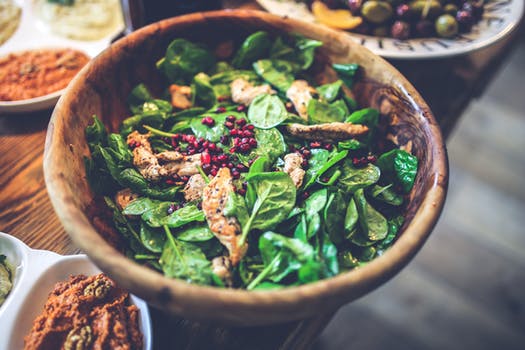Healthy Nurse, Healthy Nation™ Blog - Healthy Ways To Fill Up With Fiber
Published
Boost your daily intake with these tips.
Fiber, a nutrient found in whole grains, fruits, and veggies helps lower cholesterol, keeps excess pounds at bay, and may even prevent heart disease. Yet the average American gets a paltry 12 to 15 grams of fiber a day — a far cry from the American Heart Association’s recommended 25 grams daily.
The good news is that with a few simple tweaks, you can easily up your intake:
Step up your cereal
Mix high-fiber cereals into your regular morning bowl. Look at the “Nutrition Facts” label for varieties that include at least 5 grams per cup.
Don’t forget the flax
Flax seeds are full of fiber, as well as omega-3 fatty acids and minerals like thiamine and magnesium. Sprinkle ground flax seeds on cereal, yogurt, smoothies, or uncooked pizza dough before you cook it to hike up the amount of fiber in your meals.
Opt for oatmeal
With 4 grams per cup, oatmeal is a way to start your day with a fiber-packed punch. Both instant and old-fashioned oats have the same amount of fiber, so choose whichever is more convenient for you. Top your oatmeal with flax, berries, nuts, or banana slices to add even more fiber to your breakfast.
Eat more fruits and veggies
About one cup of raw vegetables contains five grams of fiber. In general, the more vibrant the color of the vegetable, the higher its fiber content. So, carrots, beets, broccoli, and collard greens are all fiber-rich.
Meanwhile, fruit — such as apples, bananas, and oranges — tends to have 4 grams per whole fruit. And raspberries and blackberries have 8 grams per cup. Here are 15 easy ways to add fruits and vegetables into your day.
Get a boost with beans
Most beans are very high in fiber. In fact, black beans, split peas, and lentils include a formidable 15 grams when cooked. Have beans as a side dish, incorporate them into meals, or sprinkle on salads to get more fiber in your diet. You can even find pastas made out of beans and lentils at most supermarkets for a sneaky way to add more fiber to your plate.
Go for the whole grains
When making sandwiches, choose bread with the words “whole grain,” “whole wheat,” or “sprouted grain” on the label. These types include all parts of the grain, including bran, which means they’re filled with fiber.
Choose brown foods instead of white
“Whole grain” bread tends to be brown or dark-colored. Choose other dark grains like bulgur (26 grams per cup), brown rice (8 grams per cup), or quinoa (about 20 grams per cup), instead of white rice (only 1/2 gram per cup). And try whole-grain pasta instead of traditional white pasta to double the grams of fiber per serving.
Snack on air-popped popcorn
Not only is popcorn a healthy, low-calorie snack, but each cup has more than one gram of fiber. So, a bowl of popcorn will have about 3 to 4 grams. Skip the butter and pick out a few healthier ideas from this list instead.
Incorporate nuts and seeds into your meals
An ounce of nuts or seeds, like pumpkin seeds, almonds, pistachios, or sunflower seeds, contains 3 grams of fiber. Grab a handful as a snack or sprinkle them over soups or salads for crunch.
Whip up a dip
Dips (like sour cream-based ones) and spreads (like mayo), often get a bad rap. But you can make your own or buy healthier — and fiber-packed — options like guacamole (one-half avocado has 6.7 grams of fiber), bean dip (each tablespoon contains 1 gram of fiber), or hummus (which has 7.5 grams per half cup). Dip sliced veggies in them or spread on whole-grain crackers.
Add fiber to your diet slowly
If you haven’t been making a major effort to eat fiber, add the nutrient to your diet gradually. Although fiber helps move waste through your system, incorporating too much at once may make you feel bloated or constipated. Add it to your diet little by little and in a few weeks, your body will be accustomed to it.
Do you have other ways you include fiber in your diet? Tell us on Facebook or in the discussion. Feel free to share this post on social media by clicking the icons to the left. Don't forget to tag us with #HealthyNurse.
Sources:
30 ways to get more fiber in your diet without even trying. (n.d.). Retrieved April 08, 2018.
English, Nick. (n.d.). The 16 most surprising high-fiber foods. Retrieved April 08, 2018.
Shaw, Gina. (2017, February 02). Your ultimate high-fiber grocery list. Retrieved April 08, 2018
Reviewed 12/14/22
 Have you joined Healthy Nurse, Healthy Nation (HNHN) yet? Join us today!
Have you joined Healthy Nurse, Healthy Nation (HNHN) yet? Join us today!
Blog Nutrition
05/17/2018 8:41pm CDT



Post a Comment or Question